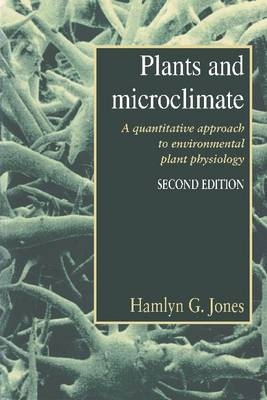
Plants and Microclimate
A Quantitative Approach to Environmental Plant Physiology
Seiten
1992
|
2nd Revised edition
Cambridge University Press (Verlag)
978-0-521-42524-7 (ISBN)
Cambridge University Press (Verlag)
978-0-521-42524-7 (ISBN)
- Titel erscheint in neuer Auflage
- Artikel merken
Zu diesem Artikel existiert eine Nachauflage
An understanding of how plants interact with their aerial environment is central to many areas of plant science. This book provides a soundly-based introduction to those features of the atmospheric environment of particular relevance to plants and describes the physical and physiological principles required for understanding how these factors affect plants.
An understanding of how plants interact with their aerial environment is central to many areas of plant science. This book attempts to provide a soundly based introduction to those features of the atmospheric environment of particular relevance to plants. It also describes the physical and physiological principles required for understanding how these factors affect plants. The underlying biophysics and biochemistry are explained in the context of plants growing in their natural environment. For example, gas exchange and diffusion are considered in relation to the control both of evaporation from vegetation and of photosynthesis and productivity, while energy exchanges are examined in relation to plant temperature regulation. Throughout the text a quantitative approach is adopted and the use of mathematical models is described with some examples. Physiological and ecological aspects of adaptation to different natural environments, including mechanisms of drought tolerance, are considered, as are possible ways in which this information can be used for 'improving' crop plants for selective breeding. Practical aspects of important measurement techniques are discussed. There is a comprehensive reference list giving an introduction to recent literature, together with appendices listing useful physical quantities. The presentation adopted is designed to emphasise the close relationship between the biophysical, physiological and ecological aspects of the adaptation of higher plants to their aerial environment. This second edition has been fully updated and includes information on novel techniques such as chlorophyll-a fluorescence and carbon isotope discrimination which can be applied to plants in the field, as well as coverage of topics of current concern such as global warming and atmospheric pollution.
An understanding of how plants interact with their aerial environment is central to many areas of plant science. This book attempts to provide a soundly based introduction to those features of the atmospheric environment of particular relevance to plants. It also describes the physical and physiological principles required for understanding how these factors affect plants. The underlying biophysics and biochemistry are explained in the context of plants growing in their natural environment. For example, gas exchange and diffusion are considered in relation to the control both of evaporation from vegetation and of photosynthesis and productivity, while energy exchanges are examined in relation to plant temperature regulation. Throughout the text a quantitative approach is adopted and the use of mathematical models is described with some examples. Physiological and ecological aspects of adaptation to different natural environments, including mechanisms of drought tolerance, are considered, as are possible ways in which this information can be used for 'improving' crop plants for selective breeding. Practical aspects of important measurement techniques are discussed. There is a comprehensive reference list giving an introduction to recent literature, together with appendices listing useful physical quantities. The presentation adopted is designed to emphasise the close relationship between the biophysical, physiological and ecological aspects of the adaptation of higher plants to their aerial environment. This second edition has been fully updated and includes information on novel techniques such as chlorophyll-a fluorescence and carbon isotope discrimination which can be applied to plants in the field, as well as coverage of topics of current concern such as global warming and atmospheric pollution.
Frontispiece; Preface to the second edition; Preface to the first edition Main symbols and abbreviations; 1. A quantitative approach to plant-environment interactions; 2. Radiation; 3. Heat, mass and momentum transfer; 4. Plant-water relations; 5. Energy balance and evaporation; 6. Stomata; 7. Photosynthesis and respiration; 8. Light and plant development; 9. Temperature; 10. Drought and drought tolerance; 11. Wind, altitude, carbon dioxide and atmospheric pollutants; 12. Physiology and yield improvement; Appendices; References; Index.
| Erscheint lt. Verlag | 4.6.1992 |
|---|---|
| Verlagsort | Cambridge |
| Sprache | englisch |
| Maße | 152 x 228 mm |
| Gewicht | 730 g |
| Themenwelt | Naturwissenschaften ► Biologie ► Botanik |
| ISBN-10 | 0-521-42524-7 / 0521425247 |
| ISBN-13 | 978-0-521-42524-7 / 9780521425247 |
| Zustand | Neuware |
| Haben Sie eine Frage zum Produkt? |
Mehr entdecken
aus dem Bereich
aus dem Bereich
Gefäßpflanzen: Grundband
Buch | Hardcover (2021)
Springer Spektrum (Verlag)
CHF 62,95
ein Baum erzählt seine erstaunliche Geschichte
Buch | Hardcover (2024)
Ludwig (Verlag)
CHF 32,15



